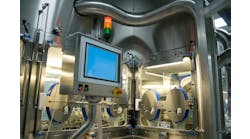| Technology Bringing the issue of infrastructure home |
If there's a shine on your shoes, there's a good chance you got it from Kiwi polish. And the fact there was polish on a store shelf in the first place is largely due to a strategic balancing act conducted by Kiwi's manufacturer, Sara Lee Corp.'s Household and Body Care Division (HBC).
A key to success for the $175 million division — with its more than 800 SKUs — is establishing and maintaining just the right balance between supply and demand. Much of that responsibility rests with Gary Kahler, HBC's director of operations and planning.
Kahler explains that about half of what he does is to coordinate the sales and operations process in the consumer packaged goods (CPG) company. The other half of his job involves having direct responsibility for the demand management and planning function in the company, which he explains as “sales forecasting both for purposes of creating demand plans for buyers — purchasing and planning people — and for financial statements.”
For the past three years, Sara Lee HBC has become strictly a sales and marketing company, outsourcing all manufacturing and distribution. “We went through a program called deverticalization,” Kahler explains, “which means shedding manufacturing assets. We decided we wanted to be a branded sales and marketing company, and don't want to become expert in manufacturing.”
That shift in core competencies lead Sara Lee HBC to sell off a plant, while the food division sold its meat packing plants, and the apparel division sold its knitting mills.
“We're now sourcing a lot of our products from our sister companies in Europe, where previously we would have tried to source domestically,” Kahler says. “There's a lot of consolidation going on within Sara Lee worldwide and shedding of manufacturing facilities, as well.”
Deverticalization has changed Kahler's supply options as HBC outsources from Europe and Asia. This has increased the interval between the time he forecasts demand and actually receives the product.
“In some instances,” he notes, “end-to-end lead-time has increased by a couple of weeks when we're sourcing offshore. In most cases, we ship by ocean, taking at least 10 days from Europe, and then customs and security concerns add time as well.”
HBC uses five public warehouses strategically located across the U.S. Kahler's group issues stocking and distribution instructions to those warehouses. “We tell them what to ship and when to ship it,” he says. “They do the in-and-out-handling, while we do the brainwork. Within the company we manage the movement of goods from suppliers to the warehouse and from the warehouse to customers.”
Technology has helped HBC. Kahler recalls that three years ago there was one demand planner taking SKU forecasts from marketing people who had no interest in doing it and, by their own admission, weren't good at it. Kahler took over responsibility for SKU-level forecasting from marketing and hired two additional demand planners. Adding new technology came next, in the form of a demand planning solution from Prescient Systems Inc.
“The biggest change we've had over the last couple of years,” notes Kahler, “is to shift our focus from forecasting SKUs to forecasting at the customer level. The most repetitive, pervasive issue for HBC is balancing inventory and customer service.”
According to Kahler, there is on-going antagonism between the product supply department wanting to keep inventories low and the sales department wanting infinite inventory. “In order to optimize the relationship between inventory and customer service,” he explains, “we stress to our sales people that the better they communicate their view of demand from the customer level in the field, the better we'll be able to service them from an inventory standpoint.”
For the HBC sales force, Kahler uses an enterprise-level forecasting module within the demand planning system, which enables the sales force to do customer-level forecasting fairly easily.
“It's easier for them to forecast now at the detail level than it was at the aggregate level years ago because the information available to them is a lot better,” he says.
With the data now available, Kahler forecasts by SKU by warehouse. The company's logistics operations determine how product supply is allocated. Customer service has visibility into stock in all warehouses, and can decide where and when to cut orders.
“Because of that visibility, if we get an order from a Wal-Mart warehouse in Texas,” says Kahler, “and our Jacksonville site — that normally would service that order — is out of something, it can then direct the order to, say, the Illinois warehouse.”
For forecast accuracy, Kahler's results have dramatically improve over the past three years. He points to the sales and operations planning process as a reason for that. Forecast accuracy has climbed to 73.0%. HBC's perfect fill rate is now 93.2%. The most important factor for the continued success of the company has been improvement in customer satisfaction.
At ConAgra Foods Inc., Rick Blasgen's challenge is to create order while managing a diverse supply chain amidst a varied product portfolio. As the company's senior vice president, integrated logistics, Blasgen oversees such brands as Armour, Chef Boyardee, Hunt's, Knott's Berry Farm and Orville Redenbacher's, among others.
As a CPG conglomerate of more than 30 brands, ConAgra has seen a great deal of change in the recent past, acquiring some companies while shutting down or consolidating others.
“When we've acquired companies, we've integrated their product lines to create scale within our supply chain in order to achieve the lowest total landed cost,” Blasgen explains. The goal is to apply the money saved toward improving margin while facilitating brand growth.
ConAgra Food's centralized logistics organization is located in suburban Chicago. That facility manages all distribution centers and transportation.
There is an effort underway to simplify processes to eliminate redundancy, whether within ConAgra or its supply chain. “Over time we will phase our businesses to achieve communality in our order-to-cash cycling, with common warehouse and transportation management systems,” Blasgen says. “We are well on our way to delivering against that, having already developed a singular dry network.”
The aim is to treat all ConAgra Foods businesses as a single entity so simplify integration with its customers — not only that, but to do so as well with providers and vendors.
“We want to build a business process supported by systems, so when we acquire a new business, we can plug it right in, and get it up and running and integrated very rapidly, so it becomes part of our mainstream business portfolio,” Blasgen explains.
To a great extent, ConAgra Foods uses third-party logistics (3PL) providers for its transportation and warehousing operations. Blasgen takes advantage of technology to manage relationships between the company's 3PLs to more efficiently move products.
“We are in the process of developing a temperature control distribution network,” says Blasgen. “We'll construct new facilities and partner up with 3PLs who can provide labor and on-site management so we can provide our customers with the ability to place a single order which will take them through a single delivery — with a single invoice — by means of a common distribution network.”
ConAgra uses multiple carriers across its network, with emphasis on over-the-road carriers for its replenishment loads. The company is a heavy user of rail and intermodal services as well. In specific geographic locations, it uses carriers adept at managing shipments from local distribution centers to customers.
As Blasgen explains, “The factors most important in evaluating carrier service are on-time service, reliability and technology — they must be able to transmit standard industry information to us so we can manage our business and utilize our metrics to drive our business processes. Capacity within our networks and the value the carrier offers between our supply chain and that of our customers are important considerations.”
Technology is key to the management and success of the ConAgra supply chain. At present, Blasgen uses a combination of legacy or company-built systems as well as third-party and best-of-breed software. The company uses software from Manugistics Group Inc. for transportation management, and a Red Prairie warehouse management system in its dry network. All software is evaluated in terms of ConAgra's long-range solutions.
While simplifying its operations, the thinking at ConAgra is that its customers will win with more frequent deliveries for less inventory, allowing them to turn inventory faster.
“Throughout our distribution network, we can ship from a common point — on one truck — varied products that have in the past gone through multiple sales organizations and on multiple vehicles to the customer,” Blasgen explains. “Instead of having two separate ConAgra trucks on different sides of a building, there will now be one with all ordered products. This allows customers to make truckload weights, increasing opportunities to reduce cash flow.”
Since ConAgra also handles perishables, when it places fresher product more quickly into the marketplace, it provides the consumer with a fresher item of better quality.
Blasgen has a clear vision of the importance of good supply chain operations to ConAgra. “My goal is to have logistics be a revenue-generating engine for the company. I feel strongly that a good, effective logistics process and organization can generate revenue.”
A look at BuyGlow Inc. lends a sense of scale and possibility to CPG distribution. Confronting the same issues as much larger enterprises, John Rourke, the San Luis Obispo, Calif.-based company's president, has outsourced most logistics operations and found great success.
As the name suggests, BuyGlow sells non-toxic, glow-in-the-dark novelty products, such as flashing light-emitting diodes, glowing bracelets, necklaces, sticks, rings and miniature glowing sticks.
Rourke started selling glow products while still in high school, marketing them at venues where he was hired to work as a disk jockey. He found that he was making more money selling glow items than he was as a DJ, so began buying more products from a supplier based in Chicago.
Conducting his own research, Rourke found he could purchase the same products from a company in China for three times less than he was paying the Chicago company. As business grew, he was able to meet the minimum order amount for the Chinese supplier and four years ago he began importing the products himself.
“I found a few vendors in China and negotiated with them by e-mail,” explains Rourke. “My first order was about $3,000. Now I'm bringing in $100,000 containers. This year there will be four shipments. Next year I'll probably bump it up to six, and each shipment is getting larger.”
All business with the Chinese supplier is conducted via e-mail. In fact, BuyGlow conducts all of its marketing on the web. In particular, the company has had great success featuring its products on eBay as well as on its own web site. Outside of listing itself on selected web search engines, the only additional marketing is for ad wording on Google.
Offshore consolidation, forwarding and importing are handled for BuyGlow by 3PLs. Because of its rapid growth, once product arrived in the U.S., BuyGlow didn't have sufficient warehousing space. Too, the company has a large number of customers in the East. To solve the problem, the company uses the services of CaseStack Inc., a 3PL of transportation, warehousing and fulfillment services.
Using CaseStack warehousing in Atlanta and Matson, Ill., in addition to existing space in San Luis Obispo and Ontario, Calif., space, has been a big advantage to BuyGlow. For the company to ship to East Coast customers by usual package delivery suppliers would cost more than sending pallet-loads by truck to the East Coast warehouses.
“Since CaseStack's services are web-based, I put in orders through their site and they forward them to the proper warehouse to fulfill the order,” Rourke notes. “Generally, they ship orders on the next day.”
BuyGlow's case lot business has been growing. At present, all small parcel shipments are sent from San Luis Obispo and case lot packages go out of Ontario, Atlanta and Chicago.
“We are starting a drop-shipping program for our customers,” says Rourke. “A lot of customers buy case lots, break them into smaller units and ship them to their customers. With the new service, they won't have to break a shipment down. We'll ship smaller broken-down shipments directly to their customers. They'll save on shipping, since right now they're paying twice for it.”
Along the way, BuyGlow uses the web for its business — including its bookkeeping, shipping and sales records — so Rourke can be in front of any computer and do his work. As far as conducting specific logistics operations, he says, “I try to keep my hand out of the things I know nothing about.” LT
resources
BuyGlow Inc.
www.buyglow.com
CaseStack Inc.
www.casestack.com
ConAgra Foods Inc.
www.conagra.com
eBay Inc.
www.ebay.com
Google
www.google.com
Manugistics Group Inc.
www.manugistics.com
Prescient Systems Inc.
www.prescientsystems.com
Red Prairie
www.redprairie.com
Sara Lee Corp.
www.saralee.com
Click here to view Logistics Today's Technology Industry Pulse
Feedback on this article?
© Want to use this article?
Click here for options!
Copyright© 2003 Penton Media, Inc.
Click here to view Logistics Today's Technology Industry Pulse


